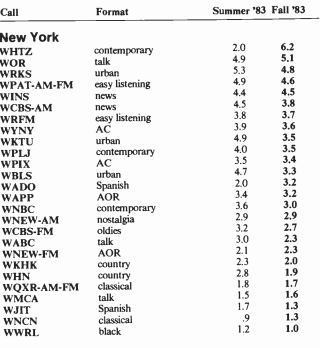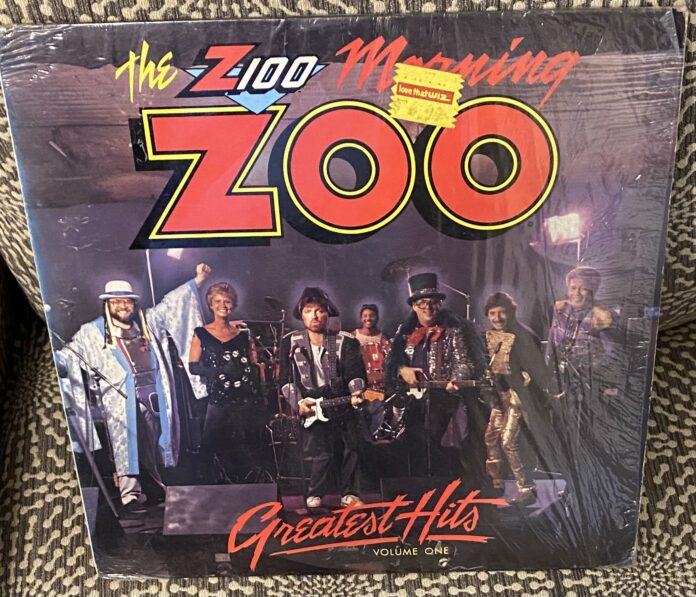At 6:08am on Tuesday, August 2, 1983, an FM radio station with a miniscule FM transmitter licensed to Secaucus, N.J., across the Hudson River from New York, officially changed from WVNJ-FM, a Jazz station barely audible outside of Northern New Jersey.
Today, WHTZ “Z100” remains a force in the New York metropolitan area, and is perhaps one of the most important of the 800-odd radio stations owned by iHeartMedia. The Z100 of August 2, 2023, is a bit different than that of yesteryear. But, paying homage to the station’s past, Editor-in-Chief Adam R Jacobson shares in this column, offers radio station owners today valuable learning lessons in how to cut through the clutter and connect with an audience in ways no other media choices can.
By Adam R Jacobson
One month before entering sixth grade at an elementary school in far-suburban New York, a locale where listening to FM radio stations from The City involved attaching the cable wire that went into our television into an FM stereo, Top 40 radio arrived in the Big Apple.
Until then, up in the Mid-Hudson Valley, there was an automated FM carrying NBC Radio Network’s “The Source” Top 40 format; a hit-driven Top 40 from Schenectady one could get in some towns closer to Albany; and AM radio after dark, when WLS was the first choice. Thanks to an introduction to shortwave radio from my Dad two years earlier, the BBC World Service also served as a major influence on providing “the hits” local radio — in particular New York City stations — did not.
At the time, my Dad worked in the family business — a seafood distribution company. On Sundays, he and a driver would leave at 10pm and go to the Fulton Fish Market, shop all night, and leave The City at sunrise for the 90 minute drive back from lower Manhattan. On the morning of August 8, 1983, thanks to chatter at the market about “a new station that poked fun at Mayor Koch,” the dial in the truck was set to 100.3 FM. Upon arriving at home later in the day, my Dad said I needed to check out this new station called “Z100,” because it was very different.
Indeed it was. From the moment Scott Shannon and the late J.R. Nelson launched the station, days before its transmitter atop the Empire State Building would fire up, a sense of goofiness and fun permeated what came out of the speakers. From circus horns to sound effects galore, from fake commercials to the “Free Money Tookie Tookie Bird,” and even Dr. Demento-era songs such as “My Wife Left Town With a Banana,” Z100 was different. And who can forget John Rio and his “Mr. Leonard” character, something that still resonates with 40-somethings today?
Yet, even with all the literal bells and whistles, Z100 played the hits. A lot. In fact, many still remember a “No ‘Maniac’ Weekend,” a promotion that guaranteed Michael Sembello’s hit from the Flashdance soundtrack would not be played, as it had aired many, many, many, many times across the 74-day period when Z100 famously soared from “worst to first.” This transpired even as WPLJ, its longtime rival across the 1980s, 1990s and 2000s, changed from Album-Oriented Rock to Top 40 just days before Z100 signed on the air. The results speak for themselves.

How did Z100 do it?
These are the Four Points to 40 Years I’ve deduced from the station’s early success, 10th birthday crisis, and current good health.
- Marketing
While “respectful irreverence” played a big part in its swift rise to the top, as Shannon infamously called out WPLJ Program Director Larry Berger, created a version of Nena’s “99 Luftballoons” attacking the station as “95 Dead Baboons,” and changing WPLJ’s call letters to “WIMP,” marketing played a major role in keeping Z100 on top once the word-of-mouth “you’ve got to check this out” drew audiences away from WYNY-FM 97.1 and WKTU-FM 92.3.
The Z100 flamethrower logo, in its first incarnation, was arguably sexy. The prizes Z100 awarded helped keep listeners tuned in, from New York Mets tickets at the height of their popularity to gift certificates to former music retailer Nobody Beats The Wiz. Television commercials promoting the “Free Money Birthday Game” would eventually come later in the 1980s.
Flash-forward to today. When’s the last time you saw a television commercial promoting a radio station? Outside of Toronto, where there’s an Adult Contemporary radio battle involving competing out-of-home advertisements, when have you seen a billboard from a non-iHeartMedia station benefiting from its Clear Channel Outdoor relationship? While some radio stations, including Independent Broadcasters Association members, are offering cash giveaways and some FMs are conducting some big-ticket concert flyaway contests this summer, are these efforts renewed after years of dormancy?
Radio needs to market itself more — and not just via social media to the consumers it already has. In an age when subscription fatigue is a big subject among those in the television industry, it is a discussion Radio is only starting to tackle. Case in point: A liner during a 60-minute commercial free music sweep on Tuesday morning at WMMX “Mix 107.7” in Dayton, Ohio, that promoted how one didn’t need to worry about not paying the subscription bill to enjoy the commercial free music the iHeartMedia station was offering.
2. Comedy and Celebrity
As we prepared this column, we played an old cassette recording of Z100’s Fifth Anniversary broadcast. Yes, all of the goofy “Morning Zoo” elements of the 1980s seem outdated and perhaps corny by today’s standards, but it brought fun to the radio in an era when a Soviet nuclear missile strike or contracting AIDS were among a high school’s biggest worries. Today, we are three years from the COVID-19 pandemic’s worst days, in a politically divided nation tackling climate change, what “community standards” belong in each ZIP code, and picking and choosing how we spend our money. Wouldn’t a little more genuine fun on the radio bring more listeners, and thus more advertising?
The success of Z100 also brought the celebrities. From August 1983 through August 1988, Z100 had welcomed James Taylor to the “Zoo.” James Taylor? A recording artist Z100 never associated itself with, except perhaps once in an infamous Scott Shannon “throw this on and see what happens” moment? Yes. Because Z100 was the radio station the stars went to, to hang on the “Zoo.” And, who the “stars” were was based on who the listeners were. On Veterans Day of 1988, I visited Z100’s former studios and offices at 333 Meadowlands Parkway. My cousin had successfully bid for a tour at a fundraiser. Somewhere in storage there’s a Polaroid of my sister, my cousin’s son, and I with longtime Shannon co-host Ross Brittain and guests Brian and Scott Bloom, teen idols of the era.
Even in an era of syndication, where a Dayton Top 40 station airs a New York-based morning show, a little bit of star power can make a show shine.
3. Interactive Engagement
One of the “Zoo” hallmarks was creating comedy from listener phone calls. From hilarious mispronunciations of young Eric Nugle’s name to the Quebec town of Chibougamou to listener tales of car inadvertently driven into a septic tank, Z100’s audience kept the morning show rolling. And, when it didn’t, it was noticeable. A March 1985 aircheck of the Zoo on a day when Shannon was not on the air saw producer J.R. Nelson and Shannon’s co-host at the time, Jack Murphy, slog through the shift.
4. Consistency
In August 2021 I penned a column about Z100’s birthday, focusing on Shannon’s efforts.
But, as Z100 celebrated its 10th birthday, troubles permeated the radio station as its founding programmer, Shannon, could be found across the street at WPLJ. In July 1993, morning zookeeper Gary Bryan had left. As August 2, 1993 arrived, Milton Maltz’s Malrite Communications officially completed its merger with Shamrock Communications; then-VP of Operations and Programming Steve Kingston, responding to a soft Contemporary Hit Radio product flow, tilted the station toward Alternative.
Kingston, it can be said, “saved” Z100 — at least the brand. There had been industry chatter that “ShamRite” was thinking of abandoning “Z100,” which in the Spring 1993 Arbitron ratings was defeated by WPLJ, 12+, while WQHT “Hot 97,” still more freestlyle dance-focused than hip-hop, was right behind it. By fall 1993, Z100 was tied for No. 4 overall, averting a death sentence by keeping the brand while all but changing formats. By April 1994, Z100 could be heard playing “The More You Ignore Me…” by Morrissey regularly.
Yes, the music was remarkably different. But, “Z100” itself wasn’t. With Kid Kelly and an air staff with a unique delivery and intonation, along with Frank Foti‘s revolutionary modulation and engineering prowess, the “Z100 sound” was still there — even if the jingles and pop tunes were not. It speaks of consistency, and sticking with what the listeners want — even in times of trouble.
We conclude this column by looking at the last 25 years of Z100. And, with perhaps a fifth “Way to Win.” Don’t give up, and fight with passion for what you truly believe the listener wants.
In April 1996, Elvis Duran took over the morning show at Z100, joining Elliot Segal. Z100’s ratings in one year sunk from a 3.8 share to a 2.8 share. By fall 1996, Z100 would dip to 18th place as a reincarnated WKTU dominated Gotham.
Was this now the beginning of the end of Z100? Not a chance. Fueled largely by Duran and pivot back to pop music thanks to the arrival of “Britney and the Boy Bands,” Z100’s 15th birthday saw the station reveling in a No. 4 finish, 12+, in the Spring 1997 Arbitron ratings, earning a 5.1 share. WKTU had dipped to a 4.2 share. By fall 1998, Z100 remained solidly ahead of WKTU while WPLJ was suffering from some of its lowest overall ratings in recent memory.
Elvis Duran “saved” Z100 — by reestablishing the brand as a home for hit music, in addition to entertaining personalities, contests and fun.
Over the early 2000s, Z100 would regularly place in the Top 3, 12+, in Arbitron’s ratings for New York. Today, 40 years later, WPLJ is now the New York Tri-State Area’s home for the KLOVE Christian Contemporary Music format. WKTU is a sibling, with just enough differentiation from Z100 to keep both brands successful.
Oh, and that 40-year-old brand? It’s No. 5, 6+, in June 2023, serving a universe where, even with YouTube, Spotify, SiriusXM, WBLI, K104.7, and TikTok, listeners still tune in for what Z100 has always excelled at — even during its Tween funk.
Will Z100 be celebrated on its 50th anniversary? Chances are, we’ll still be paying homage to “Rock Me Mr. Leonard,” Scott and Ross, Elvis Duran and all that New Yorkers have enjoyed for 40 years on the FM dial.
Adam R Jacobson has served as the Editor-in-Chief of the Radio + Television Business Report since August 8, 2016. From December 1995 until August 8, 2006, he was a staff writer, editor and columnist at Radio & Records. He began listening to Z100 on August 8, 1983, with the “Morning Zoo” greatly influencing his career path. Adam is a native of Kingston, N.Y., where listening to Z100 required connectivity via cable through the local service provider.





